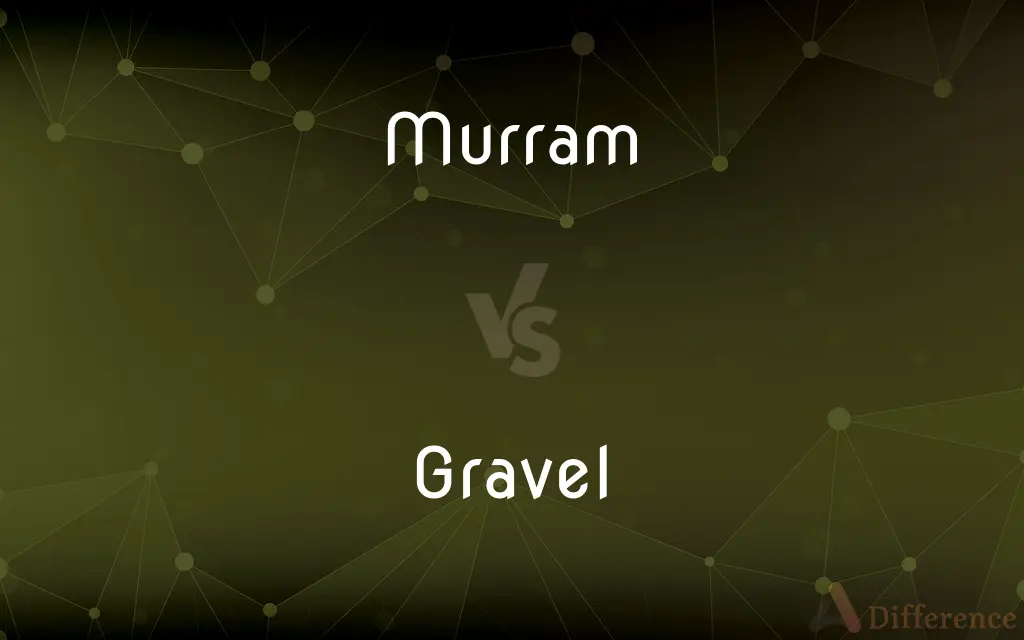Murram vs. Gravel — What's the Difference?
By Maham Liaqat & Urooj Arif — Updated on March 24, 2024
Murram is a naturally occurring laterite soil used in road construction, especially in rural areas, while gravel consists of rock fragments used in various construction projects.

Difference Between Murram and Gravel
Table of Contents
ADVERTISEMENT
Key Differences
Murram is a type of laterite soil, found in tropical regions, commonly used for constructing rural roads due to its compactability and cost-effectiveness. Gravel, composed of rock fragments, is widely used in construction for concrete production, driveways, and as a base layer for roads, offering durability and drainage properties.
Murram's composition includes iron and aluminum oxides, giving it a reddish color and the ability to harden under compression, making it suitable for road surfaces in regions lacking heavy rainfall. Gravel, with its varied rock composition, including granite, limestone, and quartzite, provides structural integrity to construction projects and is chosen for its size, durability, and drainage capabilities.
The use of murram is prevalent in African and some Asian countries, where it is favored for rural road construction and low-traffic areas, serving as a cost-effective and locally available material. Gravel's usage is global, in both rural and urban settings, for infrastructure projects, landscaping, and as aggregate in concrete, reflecting its versatility and widespread availability.
In terms of maintenance, murram roads require regular upkeep to manage erosion and potholes, especially in areas prone to heavy rains, highlighting its limitation in wet climates. Gravel surfaces, while also needing maintenance, are more resilient to weather variations and can provide a stable surface with proper installation and periodic replenishment.
Environmental considerations for murram involve the sustainable extraction and minimal processing, making it a low-impact material, albeit with usage limitations due to its performance in various climates. Gravel's environmental impact includes quarrying and the energy-intensive process of crushing and sizing, though recycling and local sourcing can mitigate these effects.
ADVERTISEMENT
Comparison Chart
Composition
Laterite soil with high iron and aluminum oxides.
Rock fragments, including granite, limestone, and quartzite.
Color
Typically reddish due to iron oxides.
Varies widely based on rock type.
Usage
Primarily in rural road construction and low-traffic areas.
Diverse, including concrete production, road bases, driveways, and landscaping.
Durability
Compacts well but may erode under heavy rainfall.
High durability and good drainage, suitable for various climates.
Maintenance
Requires frequent maintenance in wet conditions.
Requires periodic replenishment but generally more resilient.
Environmental Impact
Low-impact extraction and minimal processing.
Energy-intensive quarrying and processing, with potential for recycling.
Compare with Definitions
Murram
Common in tropical regions with laterite formations.
Murram is widely available in certain parts of Africa and India.
Gravel
Composed of rock fragments, used in various construction projects.
They laid gravel as a base layer for the new driveway.
Murram
Naturally occurring laterite soil used in construction, especially in rural road construction.
The community used murram to improve the village's main road.
Gravel
Provides good drainage and structural base for roads and construction.
The gravel layer ensured that the parking lot remained well-drained.
Murram
Characterized by its reddish color and ability to compact under pressure.
The reddish murram road hardened well under the summer sun.
Gravel
Used globally in both rural and urban construction projects.
Gravel is a versatile material, used from garden paths to major highways.
Murram
Chosen for its cost-effectiveness and local availability in suitable regions.
Murram was selected for the project due to its affordability and immediate availability.
Gravel
Environmental considerations include the impact of quarrying and processing.
The construction company chose recycled gravel to minimize environmental impact.
Murram
Requires regular maintenance to combat erosion.
After the rainy season, the murram road needed repairs to fill in the potholes.
Gravel
Sourced from river beds or quarried rock, often requiring crushing and sizing.
The gravel was sourced from a nearby quarry, ensuring a consistent size for the project.
Murram
Laterite.
Gravel
Gravel is a loose aggregation of rock fragments. Gravel is classified by particle size range and includes size classes from granule- to boulder-sized fragments.
Gravel
An unconsolidated mixture of rock fragments or pebbles.
Gravel
(Medicine) The sandlike granular material of urinary calculi.
Gravel
To apply a surface of rock fragments or pebbles to.
Gravel
To confuse; perplex.
Gravel
(Informal) To irritate.
Gravel
(uncountable) Small fragments of rock, used for laying on the beds of roads and railways, and as ballast.
Gravel
A type or grade of small rocks, differentiated by mineral type, size range, or other characteristics.
Gravel
A particle from 2 to 64 mm in diameter, following the Wentworth scale.
Gravel
Kidney stones; a deposit of small calculous concretions in the kidneys and the urinary or gall bladder; also, the disease of which they are a symptom.
Gravel
A lameness in the foot of a horse, usually caused by an abscess.
Gravel
(rare) Inability to see at night; night blindness.
Gravel
Gravel cycling, a discipline in cycling different from road cycling, mountain biking or cyclocross, for a large part on gravel roads, typically with a dedicated gravel bike
Gravel
(transitive) To apply a layer of gravel to the surface of a road, etc.
Gravel
To puzzle or annoy.
Gravel
To run (as a ship) upon the gravel or beach; to run aground; to cause to stick fast in gravel or sand.
Gravel
To check or stop; to confound; to perplex.
Gravel
To hurt or lame (a horse) by gravel lodged between the shoe and foot.
Gravel
Small stones, or fragments of stone; very small pebbles, often intermixed with particles of sand.
Gravel
A deposit of small calculous concretions in the kidneys and the urinary or gall bladder; also, the disease of which they are a symptom.
Gravel
To cover with gravel; as, to gravel a walk.
Gravel
To run (as a ship) upon the gravel or beach; to run aground; to cause to stick fast in gravel or sand.
When we were fallen into a place between two seas, they graveled the ship.
Willam the Conqueror . . . chanced as his arrival to be graveled; and one of his feet stuck so fast in the sand that he fell to the ground.
Gravel
To check or stop; to embarrass; to perplex.
When you were graveled for lack of matter.
The physician was so graveled and amazed withal, that he had not a word more to say.
Gravel
To hurt or lame (a horse) by gravel lodged between the shoe and foot.
Gravel
Rock fragments and pebbles
Gravel
Cause annoyance in; disturb, especially by minor irritations;
Mosquitoes buzzing in my ear really bothers me
It irritates me that she never closes the door after she leaves
Gravel
Cover with gravel;
We gravelled the driveway
Gravel
Be a mystery or bewildering to;
This beats me!
Got me--I don't know the answer!
A vexing problem
This question really stuck me
Gravel
Unpleasantly harsh or grating in sound;
A gravelly voice
Common Curiosities
What are the main differences between murram and gravel?
The main differences lie in their composition, with murram being a type of soil and gravel consisting of rock fragments, and their typical uses and durability in construction projects.
Why is murram favored in rural road construction?
Murram is favored for its cost-effectiveness, local availability, and suitable compacting properties, making it ideal for rural roads and low-traffic areas.
What is murram?
Murram is a type of laterite soil used primarily in road construction, especially in rural areas, known for its compactability and reddish color.
Is murram suitable for all construction projects?
Murram is particularly suitable for rural road construction and low-traffic areas, but it may not be ideal for high-traffic or heavy-load applications due to its erosion potential in wet conditions.
How is gravel used in construction?
Gravel is used in various construction applications, including as a base for roads and driveways, in concrete production, and for landscaping.
What maintenance does a gravel surface require?
Gravel surfaces may need periodic replenishment and leveling to maintain a stable and well-drained condition, especially in high-traffic areas.
Can gravel be environmentally friendly?
Gravel's environmental friendliness depends on factors like sourcing, processing, and the use of recycled materials, with efforts to mitigate quarrying impacts and energy use.
Are there alternatives to murram and gravel in road construction?
Alternatives include asphalt, concrete, and other stabilized soil materials, each chosen based on factors like cost, durability, and environmental impact.
How does rainfall affect murram roads?
Heavy rainfall can lead to erosion and the formation of potholes in murram roads, necessitating regular maintenance.
How is gravel prepared for construction use?
Gravel is often quarried or sourced from river beds, then crushed and sized to meet specific construction requirements.
Share Your Discovery

Previous Comparison
Largess vs. Largesse
Next Comparison
Strong vs. StronglyAuthor Spotlight
Written by
Maham LiaqatCo-written by
Urooj ArifUrooj is a skilled content writer at Ask Difference, known for her exceptional ability to simplify complex topics into engaging and informative content. With a passion for research and a flair for clear, concise writing, she consistently delivers articles that resonate with our diverse audience.














































